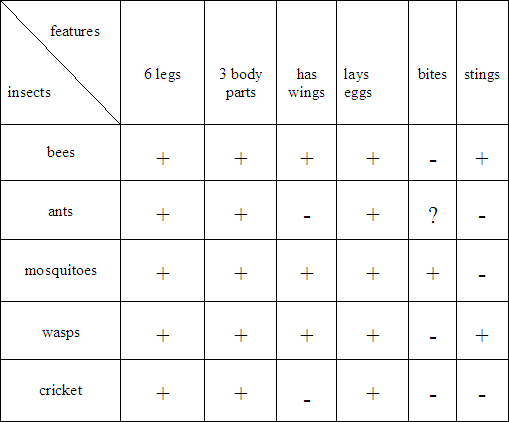Semantic Feature Analysis
- Middle elementary and above
- Expository and narrative texts
- Vocabulary development
- Assess/develop/activate prior knowledge
- Motivation
- Link new concept to prior knowledge
- Identify similarities and differences
- Identify relationships among concepts within a category
- Differentiate among the meanings of related words
- Summarize/review information

Strategy steps:
- Select a category.
- SFAs can be constructed for most categories of words.
- With students new to this procedure, select categories that are concrete and familiar.
- The category word can be a vocabulary word or it may be one of the major topics of the story or selection.
- Write the category in the top left-hand box of the grid.
- List words in the category.
- List three or four words that name concepts or objects related to the category down the left side of the grid.
- Add features.
- Write three or four features (traits, characteristics, properties) of the category across the top of the grid.
- Start with only a few features and allow students to add more later.
- Determine feature possession.
- Guide students through the matrix, asking them to decide if the word on the left of the grid has each of the features listed across the top.
- If they decide that it usually has a feature, put a plus (+) sign in the box.
- If it does not usually possess that feature, put a minus (-) sign in the box.
- If the students are unsure, put a question mark in the box. The question mark serves as a place holder, allowing discussion to continue while marking an area that will require investigation.
- Add more words and features to the grid.
- Add more words that fit the category and features that apply to those words.
- Students then complete the grid individually, with a learning partner, or in a small group. They can use reference books and other sources to find the answers for the boxes marked with question marks.
- Discuss the grid.
- Students examine the completed grid carefully, noting the similarities and differences among the words.
- Ask them which words in the categories seem to be the most alike (share the most common features).
- Ask which ones seem to be the most different. Guide them in making generalizations as well as in noting the unique features of words.
Discussion is an integral part of this procedure. As students examine and discuss the finished grid, they make judgments about the words. Once the students are familiar with this technique, the teacher can serve as a facilitator, allowing the students to do most of the completion and analysis of the grid. Eventually students take an active role in planning the grid and selecting the words and features to be compared.